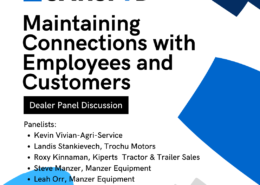Tackling Customer Issues at Your Dealership
A Step-by-Step Guide for Creating a Formal Issue Resolution Process
Your customers are the key to success and their opinions are vital to sustaining growth. With social sharing on the rise, customers can now easily share their opinions with the world. Bad experiences can quickly alter your organization’s image and detract new customers before they even walk through your door.
Let’s be realistic, customers are expecting more, making it impossible to prevent or stop issues from arising altogether. Having a defined issue management process gives your employees clear direction and responsibility for handling customer issues ‘your way’, including response timeframes, follow-up, documentation, and ultimately improving processes to prevent issues from recurring. And if you don’t have an issue resolution process, this should compel you to start.
Download the Step-by-Step Worksheet for Creating a Formal Issue Resolution Process
Expect the best, plan for the worst, and prepare to be surprised. – Denis Waitley
Here are 8 steps for Implementing a Customer Resolution Process at your Dealership.
(Download the SATISFYD Step-by-Step Worksheet for Creating a Formal Issue Resolution Process to follow along with these steps.)
1. Define your approach
In one sentence, define your dealership’s approach and philosophy to resolving customer issues. Be sure it includes your dealership’s core values. It’s important to complete this step first before going any further, as you will use it later when you define your Issue Resolution Framework. Here’s an example:
Our goal is to resolve customer issues by first understanding the customer’s expectations, then working together to agree on a solution that is delivered with the highest quality, professionalism, and courtesy.
2. Define what constitutes an issue
In a few sentences, clarify within and across your organization what constitutes an ‘issue’, and who will contribute to its resolution. Here’s an example of a dealer’s issue definition:
Any customer concern, question, survey or purchase that creates doubt, uncertainty or difficulty. An issue can occur both in-store, over the phone, online or in a survey. An issue is automatically created with a customer if they score our service a 6 or below. An issue will be resolved by the department in which the customer interacted.
3. Establish a framework for staff to resolve problems
Do you have a list of steps or guidelines your team follows to close an issue? A recent trend resulting from acquisitions is inconsistent levels of service across an organization or between stores. When all employees follow the same process when addressing customer issues, you create not only better customer experiences but consistent experiences as well. Customers can count on being treated with the same professionalism and courtesy no matter the location or department they visit. That’s one reason McDonald’s, Starbucks, Apple, and Southwest are market leaders – their customer experience is the same regardless of location.
When you establish your customer resolution framework be sure it reflects your approach and philosophy from Step 1 above. We’ve provided our framework to get you started. We recommend expanding on what we’ve included and define how each step in the framework is used for in-person, email, text, website and survey generated issues. Define parameters staff can follow, and establish an escalation process for unusual situations. Here’s SATISFYD’s Issue Resolution Framework which we invite you to use at your dealership:
1. Initiate contact with empathy
2. Confirm Understanding
3. Ask if there is anything else
4. Ask for a solution
5. Commit to measurable action
6. Confirm actions meets customer expectations
4. Create a place for employees to record the steps they took
Create a place for your employees to record the steps they took to resolve the issue. If you are a SATISFYD user, you can record the steps using the Issue Tracking section of the application. If you are currently not a licensed SATISFYD user, find a place internally that is accessible to all employees. Include the following to record the issue and explain the steps taken to close the loop: customer name, source of feedback, issue detail, issue resolution details, date contacted, date closed, employee name.
5. Define appropriate length of time to close the loop
The amount of time it takes to resolve issues will vary by dealership, location, and department. Set a clear goal to close out issues in a short amount of time, and establish regular communications with customers whose issues cannot be resolved within that timeframe. There is nothing worse than being a customer and hearing nothing for days or weeks about an open issue.
Provide reports monthly or quarterly to share how well you are meeting your customer resolution goals, including the number of issues closed and the average length of time to close the loop. SATISFYD Issue Tracking solution provides users with this data in order to calculate these metrics. If you notice some are extremely long, find ways to shorten that time frame.
6. Train on a regular basis
Make customer feedback and issue resolution a part of your every day. Bring new issues to your team and strategize on how to handle them moving forward. Consistently roleplay with staff on these topics to prevent issues from happening with your customers. New situations will always arise in your dealership, and by continuing to learn what is important to your customers and sharing strategies to resolve issues you will improve future customer experiences.
7. Conduct periodic audits
Conduct periodic audits of your customer resolutions – at minimum on a quarterly or semi-annual basis. When you first establish a customer resolution process you may find your framework needs tweaking. Dive in and examine whether there too many steps that make it too time-consuming or perhaps a step is missing that would give you more insight. Continually monitor the framework and improve it to grow with your customer base. As you continue to improve your resolution process, you can incorporate specific frameworks for departments, issue types, etc.
8. Encourage on premise follow up
Go that extra mile! If you have loyal customers that consistently spend good money at your dealership, go to them. By saving them a trip to your store to resolve their issue you will keep them coming back to you instead of a competitor. If this is a priority in your dealership, put this guideline in your framework so employees know that certain customers must get an onsite visit if a concern or issue occurs.







